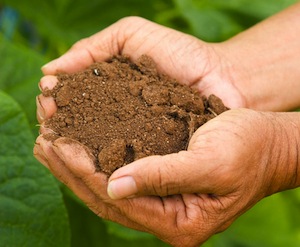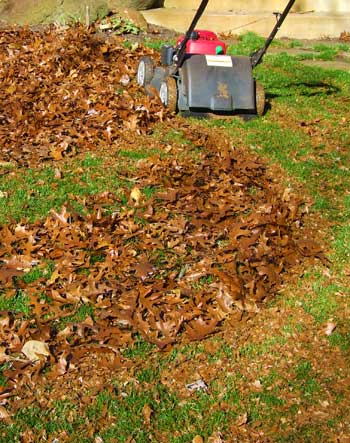Fall Soil Care: Developing Disease Resistant Soil
by Janet Scheren, Fairfax Master Gardener
 Fall is the best time of year for lawn care, but it’s also time to give your garden beds some extra attention to ensure healthier and more abundant crops next year. This is especially true for annual vegetable beds and annual flower borders. Soils that sported tomato plants, which are susceptible to three types of blights, as well as flowers and crops susceptible to powdery mildew and other blights should be top on your list. They need extra care to build disease resistance.
Fall is the best time of year for lawn care, but it’s also time to give your garden beds some extra attention to ensure healthier and more abundant crops next year. This is especially true for annual vegetable beds and annual flower borders. Soils that sported tomato plants, which are susceptible to three types of blights, as well as flowers and crops susceptible to powdery mildew and other blights should be top on your list. They need extra care to build disease resistance.
Start with cultural care. This means cleaning beds of dead leaves and stalks as well as any weeds that will persist past frost. This removes detritus, which can overwinter pests and disease. Any plant tissue that is infected with powdery mildew, phytophthora or other soil borne disease should be burned safely or bagged as trash and sent to be burned. Don’t include diseased plant material in your compost bins or in the paper bags of yard waste set out for collection.
Next it’s time to amend your soil. The goal is to build soil that actually suppresses disease.
Research into soil pathogens, such as phytophthora — one of the microorganisms causing blight in tomatoes and so many other plants and crops — can live more than 10 years in the soil and is not responsive to fungicides or most standard treatment regimens. However, leading soil and agricultural scientists are discovering that ensuring sufficient organic matter and trace minerals along with building a diverse microbiome creates soil that suppresses disease causing pathogens of all sorts. And it does it way better and cheaper than traditional approaches. Thriving colonies of diverse bacteria, fungi and other microorganisms can attack and eliminate bad players before they enter the plant roots. They also eliminate excess carbohydrates needed for these bad players to take hold and do their damage.
The key fundamentals to building disease suppressive soil are:
Soil Mineralization
Soil tests only evaluate a dozen or so key minerals. It turns out many more are needed — virtually the full periodic table. Historically, agricultural societies started in river valleys where annual floods or mineral-rich rain flowing down the mountains replenished and remineralized the soil on a regular basis. We don’t have that benefit in most suburban gardens, so it’s beneficial to ensure your garden beds are refreshed from time to time. Each crop harvested takes with it the minerals that are most biologically valuable and available. The best options are those that roughly correspond with the remineralization processes in nature. These include glacial rock dust, basalt rock dust, Azomite, gypsum, fish emulsion, liquid seaweed or seaweed granules. The last three are not only high in trace elements; they are also bioavailable and provide a good source of organic matter as well. Fish emulsion and kelp can also be used as a foliar spray to add disease resistance.

Mower shredding leaves produces leaf mulch
Organic Matter
Another factor is the biological health of your soil. Microbial activity and the full range of microarthropods and worms are critical to the soil food web. Lack of organic matter, use of pesticides or herbicides or inadequate soil moisture all limit microbial activity and life in your soil, and as a result, the ability of your crops to get the nutrients they need from the soil. Fall is a great time of year to add organic compost such as leaf mulch or alfalfa pellets. It allows them to percolate with microbial activity over the winter and be ready for spring crops. Add as much as you can afford; 1 to 4 inches should be sufficient but add more if you can. Leaf mulch provides a host of nutrients stored up by trees for a full year. Alfalfa is particularly beneficial and recommended to help remediate beds where tomatoes and other plants with disease pressure grew because this plant is a known bio accumulator. Its roots shoot down to 25 feet in the soil gathering essential minerals other roots cannot reach. Alfalfa pellets, typically sold as livestock feed, provide a rich source of minerals along with organic matter for a modest cost.
Inoculants
While many dedicated gardeners are already applying mycorrhizal fungi to garden beds, they may not realize it is a form of inoculant to their soil. They may also be aware that many beans and peas require specific inoculants to germinate and thrive. Some seeds come already inoculated. Inoculants help to establish a functioning microbiome to support soil and, thus, plant health, in the same way that vaginal deliveries and breast feeding help babies establish a healthy human microbiome. Beyond the diversity of a healthy microbiome in your soil, different crops benefit from different microbes. Several seed and garden companies sell inoculants for specific crops.
Feed Soil Life
It all comes down to maximizing photosynthesis to provide energy for the plant to grow and produce soil exudates that feed beneficial bacteria and fungus in the soil. These essential garden workers mine, digest and share minerals and other essential nutrients back to plant roots in exchange for their next meal of the rich sugary carbohydrates courtesy of the roots. That’s why keeping active growing roots in the soil is essential for building disease suppressive soils. This is a huge factor in the benefit of cover crops and green mulches. Yes, they anchor the soil in place to prevent erosion. Yes, they shade the soil from direct UV rays that can wreak havoc on delicate soil microbes. Yes, they help to insulate soil from temperature extremes. Perhaps even more importantly, having roots in the ground year-round helps to build a healthy and thriving microbial colony and the microarthropods and worms that live among them.

Phytopthora on pepper plant
Understanding Phytophthora — and other diseases like it —
While phytophthora may look like a fungal disease, it is actually a type of water mold called oomycete. These organisms are part of a newly defined kingdom, Chromista, rather than a fungi. Oomycete cell walls are made of cellulose, the same as plant cell walls. Fungi cell walls, in contrast, are made primarily of chitin, the long-chain polymer that also makes up the exoskeletons of arthropods, and which is similar to the protein keratin. Most fungicides are formulated not to damage cellulose-based plants, thus they don’t work on phytophthora either. In addition, this organism evades the cultural practice of crop rotation because it can live in the soil for more than 10 years, while most crop rotation plans only allow three to four years before returning to Family of plants. There are more than 100 known species of phytophthora. These affect a wide array of crops from strawberries, blueberries, fir trees, spruce, holly, dogwood and ash to peach, cherry, pear, junipers, crab apples, potatoes and many more. In addition to phytophthora, there are many other organisms that blight plants. Some cause root rot in wheat. However, all forms of blight can be held at bay by disease suppressive soils.
Much remains to be learned about what balances of organisms create the most disease-suppressive soil. Labs across the world are gaining new insights each year. While scientists don’t have all the answers today, you can make progress now in building disease suppressive soil. You will see the results in your garden next year and even better results the following year.
Resources
• Disease Suppressive Soils: New Insights from the Soil Microbiome, Phytopathology, National Library
of Medicine
• What is Phytophthora? Oregon State University, College of Agricultural Science
• Phytophthora in Disease-Suppressive Soils: Even the Scourge that Caused the Irish Potato Famine
Can Be Stifled…, Nathan Harman, ACRES USA